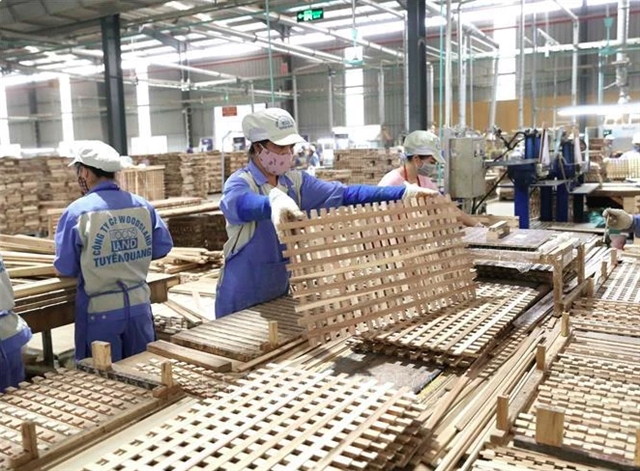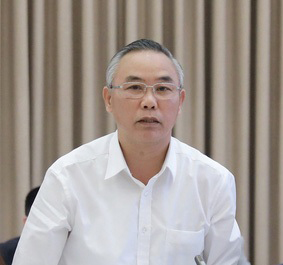 Economy
Economy

 |
| Deputy Minister of Agriculture and Rural Development Phùng Đức Tiến. — VNS Photo |
After reaching more than US$40 billion in the first eight months of the year, the export of agricultural, forestry and fishery products is expected to hit $54 billion this year. Deputy Minister of Agriculture and Rural Development Phùng Đức Tiến sat down with Việt Nam News reporter Tố Như to talk about this breakthrough.
The figures for exports of agricultural, forestry and fishery products over the past eight months have been very promising. What has been the driving force behind the achievement of over $40 billion in exports in just eight months?
The export value of agricultural, forestry and fishery products reached $5.55 billion in August, an increase of 12.3 per cent compared to the same period last year.
This includes key agricultural products at $2.99 billion, up 22.6 per cent, forestry products at $1.45 billion, up 4.7 per cent, and fishery products at $900 million, up 5 per cent.
Livestock products were $46.5 million, down 4.8 per cent, and production inputs were $161 million, down 23 per cent.
For the first eight months of the year, almost all product categories showed growth, with total export value reaching $40.08 billion, an increase of 18.6 per cent.
Contributing to this result were agricultural products at $21.32 billion, up 24 per cent, forestry products at $10.97 billion, up 19.7 per cent, fishery products at $6.23 billion, up 7.6 per cent, and livestock products at $324 million, up 0.3 per cent. Production inputs totaled $1.23 billion, a decrease of 6.8 per cent.
The export value of key products has grown compared to the same period last year. Specifically, wood and wood products exports reached $10.24 billion, up 20.6 per cent year-on-year; coffee exports were $4.03 billion, up 36.1 per cent; rice exports were $3.85 billion, up 21.7 per cent; cashew nut exports were $2.77 billion, up 21.7 per cent; vegetable and fruit exports were $4.63 billion, up 30.6 per cent; shrimp exports were $2.41 billion, up 9.5 per cent; and pangasius fish exports were $1.2 billion, up 8.2 per cent compared to last year.
Notably, the average export price of rice reached $625 per tonne, up 14.8 per cent; coffee reached $3,805 per tonne, up 54.5 per cent; rubber reached $1,567 per tonne, up 16.6 per cent; pepper reached $4,810 per tonne, up 47 per cent; and tea reached $1,756 per tonne, up 2.2 per cent. In contrast, the average export price of cashew nuts was $5,701 per tonne, down 1 per cent compared to the same period.
With the results achieved in the first eight months of the year, agricultural, forestry and fishery exports are expected to meet the Prime Minister's target of $54 billion for this year. This outcome lays a solid foundation for relatively stable growth of the agriculture sector this year.
What factors have contributed to such positive results for the agriculture sector in the first eight months of this year?
To achieve this export performance, the restructuring efforts of the entire agriculture sector, as well as each industry and field, have been on the right track.
Each sector and field has specific strategies, and within each strategy, plans and projects are developed to ensure proper implementation and operation.
Furthermore, the complex global situation has presented opportunities for us to seize and penetrate new markets.
The results indicate that export values to various markets have surged. Exports to Asia reached $19 billion in the first eight months of the year, up 15.7 per cent; to the Americas reached $9.3 billion, up 22.3 per cent; to Europe reached $4.8 billion, up 30.5 per cent; to Africa reached $747 million, up 5.5 per cent; and to Oceania reached $563 million, up 12.8 per cent.
The US, China and Japan remain the top three largest export markets, with exports to the US accounting for 21.4 per cent of the total, up 23.5 per cent; to China 20.4 per cent, up 10.2 per cent; and to Japan 6.7 per cent, up 4.6 per cent.
Recently, frozen durian, fresh coconut and farmed crocodiles have officially been granted licences to enter the Chinese market. How does this open up potential for the export of these particular products and of Việt Nam's agricultural, forestry and fishery products generally?
The Ministry of Agriculture and Rural Development of Việt Nam and the General Administration of Customs of China signed three protocols on the export of frozen durian, fresh coconut and crocodiles from Việt Nam to the Chinese market.
For durian, we now have raw material growing areas with different varieties, cultivation processes, growing area codes and packaging facility codes. Therefore, the fact that frozen durian has a 'visa' to enter the Chinese market will be a huge advantage.
For coconut, we have 199,100 hectares with an output of two million tonnes. This also signifies massive potential and a big advantage for the industry.
As for crocodiles, having a licence to enter the Chinese market is not only an economic opportunity, but also a driving force for the Vietnamese crocodile farming industry to develop in a sustainable direction, ensuring environmental and animal welfare standards.
In Việt Nam, crocodile farming has developed for decades, particularly in the Mekong Delta – a place with great potential and advantages. Products such as meat and skin have very high value. Crocodiles are very easy to raise, because farmers can take advantage of excess animal products to raise crocodiles.
Recently, the export of crocodiles has encountered difficulties, so many localities and farms have had to reduce their production. However, the fact that crocodiles can officially be exported to China will help boost consumption of crocodile products.
Farmers in Việt Nam have now mastered the process of raising crocodiles, from hatching them to caring for them. The Ministry of Agriculture and Rural Development will continue to organise training sessions and provide guidance for exporters to learn about new requirements and regulations, helping localities, businesses and producers prepare for exporting to the Chinese market.
At the same time, the Ministry of Agriculture and Rural Development will closely coordinate with Chinese authorities to ensure smooth implementation of the protocols and support Vietnamese businesses and farmers to make the most of new opportunities.
Thanks to these three protocols, along with previous export products and with the participation of the Government, ministries and functional agencies on logistics like railways and smart border gates, I believe that the output and export value to the Chinese market will increase.
Despite the potential, there is a lack of cold storage systems for preservation in Việt Nam's fruit granary, the Mekong Delta region. How do you evaluate the construction of cold storage systems in these orchards?
The Mekong Delta supplies 60-65 per cent of the country's rice, seafood and fruit exports. Therefore, the Prime Minister is very concerned with the agricultural infrastructure of this region. In addition to a highway project, the Ministry of Agriculture and Rural Development is also implementing a logistics project in a number of provinces. There is a relatively large amount of money left.
The Government will also provide part of the funding for general infrastructure for agricultural products in the Mekong Delta region, including cold storage facilities and infrastructure related to preliminary processing and packaging. Starting there, we can promote the potential and advantages of this region.
In addition to key agricultural products, we also export OCOP products. However, the export value of these products is still limited. What are the main challenges?
After many years, we now have over 13,000 OCOP products rated three stars and above, which is a significant achievement. OCOP products are highly valued. However, trade promotion efforts and the scale of production for these products are still limited. Integrating OCOP products into global market distribution chains has presented challenges in promotion, branding and image building. — VNS




